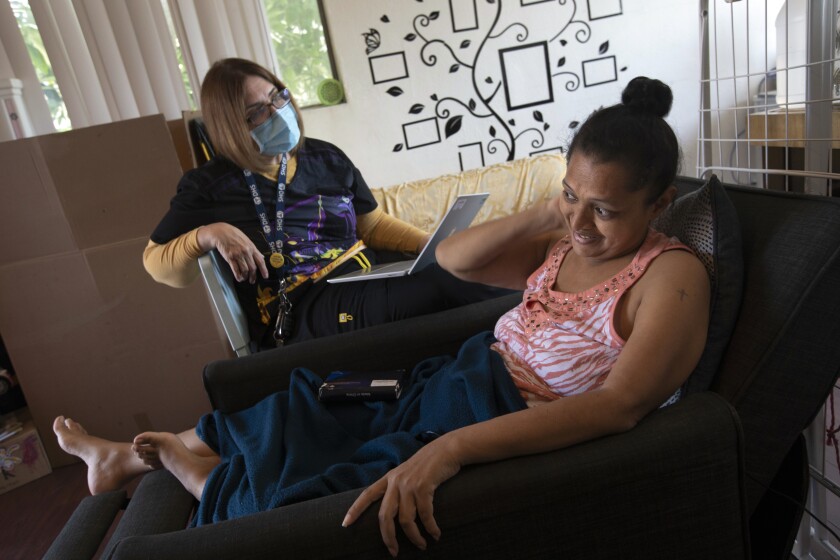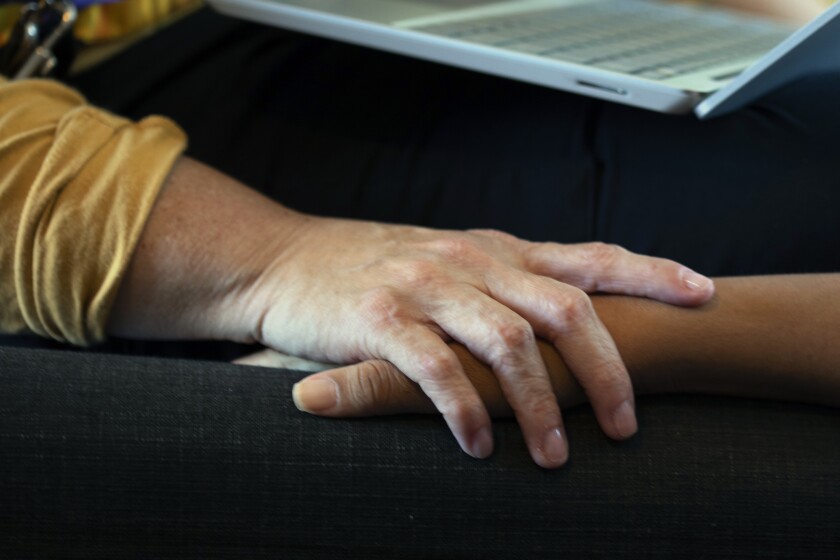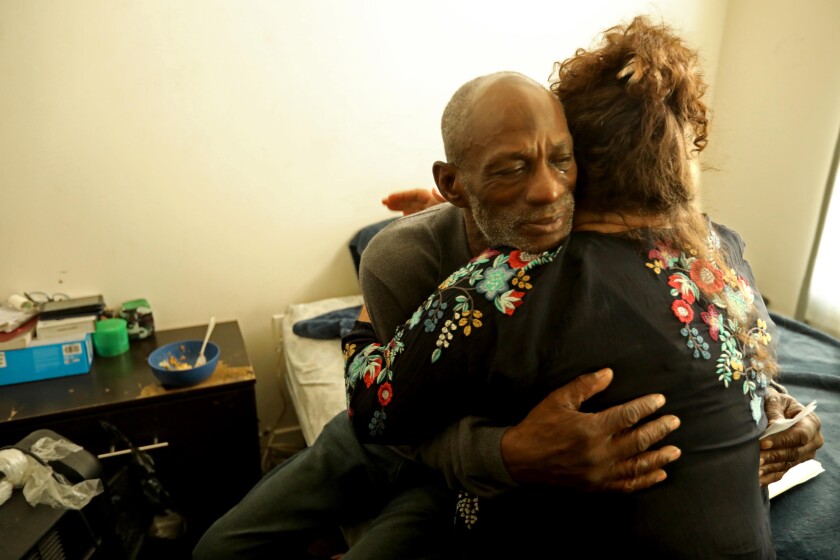Dr. Heidi Behforouz had just met with a critically ill patient in his apartment — a 58-year-old man who was hospitalized four times in six weeks — and now she was in the lobby of the building.
Through the window, skid row lived up to its name. Three men were sprawled on the pavement, and Behforouz looked down to see if one guy in particular distress might need immediate help.
“It never ceases to amaze me,” said Behforouz, medical director of a life-saving L.A. County program called Housing for Health. She did similar work in Boston before arriving in Los Angeles in 2015, and she was immediately struck by what she saw on the streets.
“It was horrifying, to be honest with you. The scale of the devastation is so much greater here than it was in Boston,” Behforouz said. “People here that I’ve been taking care of are dying at much younger ages.”
Her goal is not to help them simply survive, but to thrive, and also to provide street medicine to those not yet housed. It’s difficult, labor-intensive work involving an army of field workers at dozens of public and nonprofit agencies.
Roughly 20,000 people are getting this care from Housing for Health, but thousands of currently homeless people could use the same wraparound services from this agency and others that provide it, if only enough resources were available.
We’ve all seen them out there. The sick, the addled, the addicted — products of poverty, trauma, unaffordable housing and a silo system of often poorly coordinated care. It’s a catastrophe hard to comprehend in a state that stands as the world’s fifth-greatest economy and is home to internationally acclaimed teaching hospitals.
Last week I wrote about Sean Sauceda, who is thriving in permanent supportive housing after several years of help from Housing for Health, which has been operating for a decade. I’ve since tagged along as Behforouz’s teams visited the homes of formerly unhoused patients with serious medical conditions. Preventing expensive hospital runs, returns to homelessness and death are the goals.

Housing for Health registered nurse Elsa Harmon, left, makes a home visit with patient Perla Fuentes.
(Carolyn Cole / Los Angeles Times)
Elsa Harmon, a Housing for Health registered nurse, arrived midmorning at the Gardena apartment building of a 65-year-old patient named Miguel, who first became homeless after losing his job as a machinist. He had just returned from chemo treatment for lung cancer, was vomiting, and wasn’t up for meeting strangers. He asked if Harmon could return another day.
It gave me a chance to get to know Harmon, who grew up in Ecuador. We sat in the community room at Miguel’s building and she told me she was a computer engineer until a middle-age career shift inspired by her daughter, who worked as a nurse and shared stories of her challenging but gratifying work.
“Usually, kids follow the footsteps of their parents, but in this case, I followed my daughter,” said Harmon, who studied nursing for five years — on nights, weekends and days off — while working full time. Eight years ago, she became an RN.
“My patients are my passion, and helping people like Miguel is amazing,” she said, adding that our perception of who’s homeless, and why, can change with a closer look. “The color of your blood, my blood and everybody else’s blood is the same. You need to treat your patients with honesty and dignity. … You can’t promise them that they’re going to live forever, but you can promise them that they’ll get good care.”
That same day, Harmon announced herself at the South L.A. apartment of Perla Fuentes, who fled Honduran street crime with her two grandchildren after her daughter was killed and her home was destroyed in a fire. Fuentes said she and the kids were arrested and separated at the border, then reunited and moved temporarily into the home of a friend in L.A.
Fuentes got a job at a pizza parlor and rented a room in a house. But cervical cancer, first diagnosed in Honduras, flared. She lost the job and couldn’t afford the room, but she said she and the kids kept sleeping there, slipping in and out when the landlord was away.
She came to the attention of Housing for Health after multiple hospital stays, and the family now lives in an upstairs unit in the backyard of a house.
“Come in,” Fuentes said when we arrived. “My house is your house.”
Fuentes sat in a recliner with a blanket over the lower half of her body. She was, despite her circumstances, wearing a broad smile that made me think the prognosis was good, but I was wrong. Harmon explained that the cancer has spread, chemo and radiation treatments have been halted, and Perla’s mother is visiting on a humanitarian visa to help out.
The grandchildren, 8 and 10, fiddled in another room, and Fuentes’ mother made a lunch of fruit salad for all of us. Fuentes insisted that we eat and relax while she and Harmon carried on, holding hands as if they were longtime pals.
“I have trust in God,” Fuentes said to explain her good spirits. “I’m OK.”
“Obviously, she’s scared like any human being would be,” said Harmon, but she’s found strength in faith. “With less than that, any person would end up on the floor. … I can teach my patients about medication, but they teach me about life.”

Nurse Elsa Harmon comforts patient Perla Fuentes. a Housing for Health participant, at her apartment in Los Angeles.
(Carolyn Cole / Los Angeles Times)
Harmon went over Fuentes’ latest symptoms and dug through a satchel of pill containers, reminding her about dosages and upcoming medical appointments. When we left, Fuentes asked us to please return any time.
“My house is your house,” she said again, with a radiant smile.
A week later, Behforouz and one of her nurses, Jonah Malana — along with Housing Works case manager Jasmine Salas — met me at the home of a patient named Micaela Duarte, who lives with her son. In her late 50s, Duarte suffers from multiple advanced heart and lung ailments, as well as diabetes and hypertension.
“Sit down,” Duarte offered with a warm greeting. She sat at her kitchen table and pointed to a chair for me. Wheezing and choking, she told her visitors that family members were visiting.
“I feel blessed,” she said.
The doctor, nurse and case manager engaged Duarte with the same elegant bedside manner I’d seen Harmon use with her patient. Duarte seemed relaxed and reassured in their presence, but Behforouz and Malana found that her blood oxygen level was close to 70, more than 20 points too low.
Duarte attached herself to an oxygen tank while the doctor and nurse noticed that Duarte had not been using her new BiPap machine, which pushes pressurized air into the lungs through a mask. Behforouz noted how confusing it can be for patients to master and become comfortable using such equipment, and she and Malana set out to train Duarte.
It took a while even for the pros to make the connections and fit the respirating mask comfortably over Duarte’s face, but during an hourlong visit, the patient’s blood-oxygen level climbed into the 80s.
“She’s breathing much better now,” said the doctor.

Dr. Heidi Behforouz, right, gives a hug of support to patient Rafer Henderson during a house call.
(Genaro Molina / Los Angeles Times)
At the next stop, on skid row, Behforouz met with Rafer Henderson, 63, who is HIV-positive, has lost 70 pounds in the last year, suffers from depression and was recently hospitalized for respiratory failure. He told me that his problems, which led to homelessness, began when he developed a drug addiction during a 30-year aerospace career as a sheet metal polisher.
Behforouz sat next to Henderson on his bed, examined his throat (he’s having trouble swallowing), and said as we left that she would contact his primary care physician to share notes. Much of what Housing for Health does is sort paperwork, chip away at bureaucracy, coordinate multiple aspects of care and stay on top of it all.
L.A. County voters deserve a pat on the back for the growth of this model, which is partly funded through the quarter-cent Measure H sales tax increase approved nearly five years ago. Behforouz hopes the funding stream is extended beyond the measure’s 10-year term.
She spoke of the “incredible trauma of body and soul that” is visible to all of us. “It’s devastating because we have the technology and the wealth to tend to everybody in this country, but we don’t, and that’s what kills me over and over again.”
It is not, she said, as if we don’t know what works.
Steve.Lopez@latimes.com
